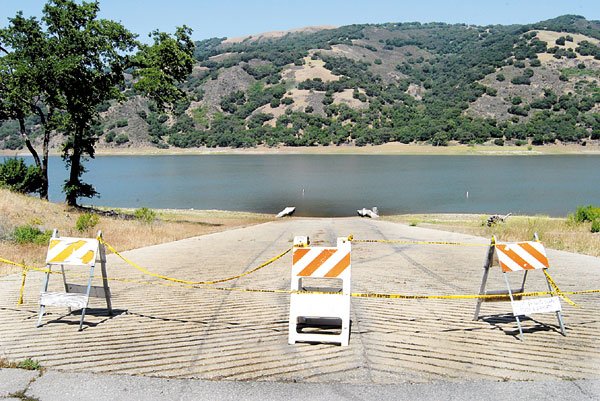Even with the recent rain and more in the forecast, the Santa
Clara Valley Water District is likely to make the call for
”
mandatory conservation
”
measures for the first time in more than 15 years.
Even with the recent rain and more in the forecast, the Santa Clara Valley Water District is likely to make the call for “mandatory conservation” measures for the first time in more than 15 years.
The district’s board of directors put its 1.7 million municipal and industrial customers on notice Tuesday that if water supplies do not improve significantly before March 24, they will be asked to cut their water use by up to 20 percent.
The region has seen about half as much rain as normal, and area weather people say it is unlikely that rainfall will reach normal levels before April. And according to board members and staff, the drought that is now in its third year is only part of the concern. Imported water shipped from outside the district has been cut by authorities higher up, resulting in dwindling overall supplies.
“Given that we’ve had a dry winter so far, we would have to have some remarkable rainfall between now and March to make a big difference (in water supply),” said district spokeswoman Susan Siravo. “It’s better to be safe than sorry, and we need to do everything we can now to conserve water.”
Agricultural water users would not be subject to the conservation mandate.
But “mandatory conservation” is not as restrictive to the average water user as it sounds, according to officials from both the district and the city of Morgan Hill. Siravo said the district does not have the authority to enforce mandatory water-saving guidelines, but would ask the retailers or cities to which it sells water to institute conservation programs.
The city’s Environmental Programs Administrator Anthony Eulo said it is unlikely that watering schedules, fines, or rationing would be imposed. He said the city may take a tougher line against “water wasters” or “gutter flooders” who violate existing laws relating to water use by, for example, letting their water hose run continuously while washing their car.
He said if the district calls for a 20 percent reduction in water use, the city would implement its “urban water management plan,” which he described as a contingency plan that all cities in the district are required to keep on file and updated in case of situations such as the current drought.
Morgan Hill’s contingency plan includes educating its customers on how to irrigate their landscaping more carefully, cutting back on irrigation of public landscaping and encouraging homeowners to buy more efficient toilets. In fact, he noted that the district has resources available to assist customers in these efforts, and last year instituted a program to help lower-income residents pay for and install water-saving commodes.
“There’s no rationing, and nothing draconian,” Eulo said. “People will be asked to be more careful about water use.”
According to a staff report presented at Tuesday’s water district board meeting, the district’s 10 local reservoirs are only at about 85 percent of their normal capacity for this time of year. Some reservoirs, such as Chesbro which is west of Morgan Hill, are “critically low” at about 8 percent capacity.
Aside from the lack of rain, new rules regulating pumping from key sources outside the district could mean 30 percent less water coming into Santa Clara County from sources such as the San Joaquin River Delta over the next year, the staff report indicated. Imported water accounts for about half of the district’s total supply.
As a result, this year the district will rely more than it ever has on a vast groundwater basin in southern California to supply local customers. Siravo said that water costs more than other imported water because it has to be transported such a long distance.
The last time the water district called for mandatory conservation was 1989, when they asked customers to use 25 percent less water until that drought ended in 1992.
Several storms coming in the next couple of weeks will probably not be enough to hold off the official call for conservation. Local weather observer Chris Henry said storms expected this weekend and the middle of next week could dump four to six inches on Morgan Hill.
As of Wednesday, the city has received only 8.71 inches of rain for the season, while in a normal year more than 15 inches would have fallen, according to Henry. He noted that since 2006, there have only been three months of above-average rainfall, including January 2008 when downtown Morgan Hill flooded as more than 11 inches fell during the month.
Furthermore, Henry said the driest year during the last drought was the winter of 1987-1988, when 13.79 inches fell. But 2006-2007, the first year of the current drought, was even drier with only 11.88 inches of rain. Average rainfall during a normal year in Morgan Hill is 24.47 inches.
“It’s too late in the year to bring us back up to normal,” said Henry. “Right now the hills are saturated, and ready for runoff. (The upcoming storms) will be very impactful, but we’ve got to see what March brings.”
The board voted 5-2 Tuesday, with directors Tony Estremera and Larry Wilson against the warning call.
Board chair Sig Sanchez said following the meeting that the need to conserve is directly related to budget concerns in the water district. He said if people and cities purchase 20 percent less water, the district will lose millions of dollars in revenue.
“We’re going to have to look at some serious cuts in our budget as far as operations,” Sanchez said.
The SCVWD provides drinking water as well as flood control to the 1.7 million people of Santa Clara County. It has an annual budget of $411 million and employs about 850 people.













